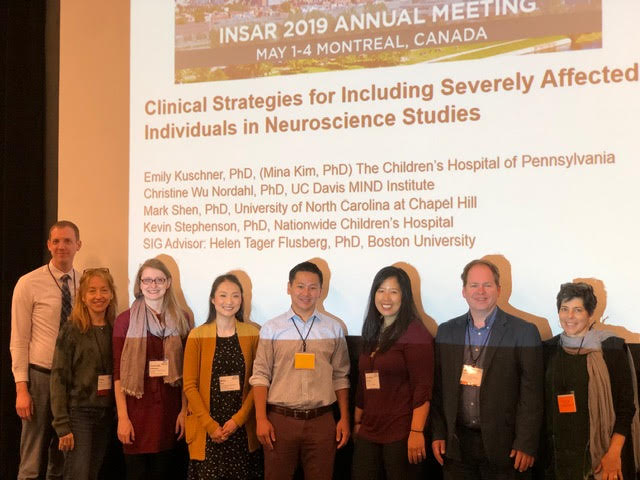A decreasing proportion of studies include the severe end of the spectrum, which represents 30-50% of the autism population. This needs to change.
Leaders of an INSAR group devoted to improving inclusion of the severely affected in neuroscience research: Kevin Stephenson, Alison Singer, Charlotte DiStefano, Mina Kim, Mark Shen, Christine Wu Nordahl, and Mikle South, with Jill Escher, president of NCSA, at right.
[Editor’s note: Alison Singer is the founder and president of Autism Science Foundation, a board member of the International Society for Autism Research (INSAR), and a board member of the National Council on Severe Autism. She made these remarks at a session of the INSAR conference on May 3, 2019 in Montreal, Canada.]
By Alison Singer
Thank you so much for inviting me to speak today. This topic is critically important because people with severe autism are being left behind. As I mentioned in the keynote address I gave at INSAR two years ago, many advocates have growing concerns that the word “autism” has grown to encompass something so broad that it is now meaningless. Autism used to mean something specific; until we moved to DSM-5 (Diagnostic and Statistical Manual 5), autism described a consistent cluster of symptoms. But today the phrase “autism spectrum disorder” has become such a big tent term that the people under that tent often have little in common with each other. Autism can mean genius, or IQ below 50. Autism can mean highly verbal or nonverbal. It can mean graduating from Harvard Law School, or “exiting” high school with a certificate of attendance. It can mean self-injury, sleep disorders, aggression, pica, wandering, biting, or not. Thanks to decades of research, we know autism encompasses core symptoms that are present in each person who is diagnosed, but their abilities are vastly different.
If we are going to be able to personalize our approach to care and provide benefits to ALL people, we need terminology and language that are specific and meaningful. In fact, the DSM-5 was supposed to do this; it was supposed to provide greater specificity so that the diagnosis would point toward potential services, but because of the way DSM-5 is applied, the opposite has happened. Everyone is lumped together as having ASD. To the broader public, the word “autism” only describes the more verbal, traditionally skilled, visible end of the spectrum, because those individuals are able to have a voice, represent themselves at meetings, and appear in the media. Unfortunately, television shows like The Good Doctor are broadcasting this brand of autism, and only this brand, to the world. The result; autistic people with the most challenging behaviors have become invisible and are being left behind.
Earlier this year a new effort was launched to utilize the term “severe autism” when describing more classic autism symptoms. As with many issues in autism, there is no scientifically precise definition of what constitutes severe. Most consider the term to encompass individuals with autism who, by virtue of any combination of cognitive and functional impairments require continuous or near continuous, lifelong services, supports and supervision. Individuals in this category are often nonverbal or have limited use of language, have intellectual impairment and exhibit extremely challenging behaviors like self-injury or aggression that interfere with safety and well-being.
It’s difficult to put a precise number on this population, but national research from the CDC indicates that of the 1 in 59 children diagnosed with autism, 31% were found to have intellectual disability and an additional 25% to have borderline intellectual disability. 30% of people with autism are considered minimally verbal, and according to work by Helen Tager Flusberg and Connie Kasari, core autistic symptoms are typically more severe in these minimally verbal individuals. They are also more likely to exhibit challenging behavior. Overall, the estimate of those with severe autism is between 30-50% of people with autism. And yet we rarely see them on TV or at the policy making table.
Earlier this year, a new organization was formed, the National Council on Severe Autism, to represent this population. The president of that organization, Jill Escher, is here today. This group is committed to directing resources to this population and to making this population more visible. And already they are seeing success. For example, the term “severe autism” is starting to take hold, and in fact was used by NIMH (National Institute for Mental Health) Director Dr. Josh Gordon at a recent meeting of the Interagency Autism Coordinating Committee. It’s sticking because it’s meaningful. It describes a clear cluster of symptoms which is key to finding appropriate interventions, services and supports.
One of the core goals of the new National Council on Severe Autism is to encourage research of this population. Recent trends in research have been toward focusing on higher functioning individuals; helping them find employment, for example, or studying ways to improve their social skills. A decreasing proportion of autism studies focus on the severe end of the spectrum. Profound impairments in communication, and disruptive behaviors often make cooperation with assessments and procedures challenging, and that’s why I am so glad this INSAR special interest group exists to share best practice on the very meaningful accommodations being developed and implemented to make autism research truly inclusive. Many members of this population cannot speak for themselves, and so this task falls to their parents. I think you will find these parents quite eager to participate in research, as in many cases it’s their children who have the most to gain. I hope you will utilize the resources of the National Council on Severe Autism and look to us for support and partnership. In closing, I want to close by thanking you for making a commitment to research those with severe autism and taking on the additional challenges this brings.
Alison Singer is founder of the Autism Science Foundation and treasurer of National Council on Severe Autism. She is the parent of two daughters, one with severe autism.


